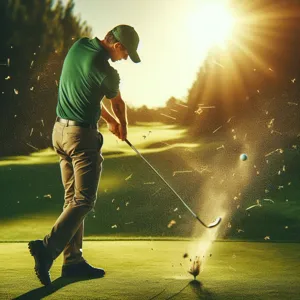For golfers seeking to elevate their game, mastering the art of driving off the tee is paramount.
The thrill of watching your ball soar down the fairway is not just a rewarding sight; it sets the tone for the entire hole. However, many players struggle with distance, often feeling frustrated as they watch their competitors outdrive them with ease. If you’ve ever wondered how to unlock that extra yardage and transform your tee shots from ordinary to extraordinary, you’re in the right place. In this blog post, we’ll delve into proven strategies and techniques that can help you crush your drives, no matter your current skill level. From optimizing your stance and grip to incorporating the right swing mechanics and equipment, we’ll provide you with actionable insights that will have you launching the ball farther and with greater accuracy than ever before. Get ready to take your game to the next level and make every tee shot count!
1. Understanding the Importance of Distance Off the Tee

When it comes to golf, the distance you achieve off the tee can significantly impact your overall game. It’s not just about hitting the ball far; it’s about gaining a strategic advantage on the course. Understanding the importance of distance off the tee is akin to realizing that each yard gained can open up a world of opportunities.
Imagine standing on the tee box, eyeing a par 4 that stretches out in front of you. The longer you can drive the ball, the shorter your approach shot will be, allowing for more manageable iron play into the green. This not only boosts your chances of hitting the green in regulation but also gives you a better opportunity to make birdies. Additionally, a longer tee shot can put pressure on your opponents by forcing them to play more conservatively, creating an upper hand in competitive situations.
Moreover, distance off the tee can lead to improved accuracy. When you can launch the ball farther, you can afford to take a more aggressive line, reducing the number of obstacles in your way. This can translate to fewer hazards and better angles into greens. Ultimately, harnessing the power of distance allows players to capitalize on their strengths, setting the stage for lower scores and a more enjoyable round.
As you delve into the strategies for crushing your drives, remember that understanding the importance of distance is the first step. It’s not merely about swinging harder; it’s about optimizing your technique, equipment, and mindset to unlock the full potential of your tee shots. By mastering this aspect of your game, you’ll not only enhance your skills but also elevate your entire golfing experience.
2. The Science of Driving: How Club Technology Affects Distance
When it comes to maximizing your distance off the tee, understanding the science behind club technology is essential. Modern drivers are marvels of engineering, designed to optimize performance and enhance every stroke. The key lies in the materials, design, and technology used in these clubs, all of which play a critical role in how far and straight you can hit the ball.
First, consider the materials. Today’s drivers often utilize lightweight composites and titanium, allowing for a larger clubhead without sacrificing swing speed. This means you can generate more clubhead speed through your swing, translating to greater distance. The sweet spot—the area of the club that delivers the best impact—has also been expanded thanks to advanced design techniques. This not only increases your chances of hitting that sweet spot but also enhances the forgiveness of mishits, ensuring you don’t lose significant distance even when your swing isn’t perfect.
In addition to materials, the design of the clubhead itself plays a crucial role. Features like adjustable weights and loft settings allow you to customize your driver to suit your swing style and personal preferences. By shifting weight within the clubhead, you can influence your launch angle and spin rate, both of which are key factors in achieving maximum distance. A lower spin rate, for instance, can help the ball travel further, while a higher launch angle can provide the lift needed to keep the ball airborne longer.
Lastly, understanding the technology behind the club can elevate your performance even further. Many modern drivers come equipped with advanced face technologies, including variable thickness and face curvature, which enhance ball speed and distance on off-center hits. Some even feature built-in sensors that track your swing data, providing insights into your performance and helping you make informed adjustments.
In summary, the science of driving is a fascinating interplay of materials, design, and technology. By selecting the right driver and understanding how these elements work together, you can significantly boost your distance off the tee, transforming not just your game but also your enjoyment of it. Embrace the advancements in club technology, and you’ll be well on your way to crushing your drives and lowering your scores.
3. Analyzing Your Current Drive: Tools and Techniques

To unlock the full potential of your drives, it’s crucial to start by analyzing your current performance. Understanding your strengths and weaknesses will set the foundation for improvement, and fortunately, there are a plethora of tools and techniques at your disposal to facilitate this process.
One of the most effective methods for evaluating your drive is through the use of launch monitors. These sophisticated devices capture a wealth of data about your swings, including ball speed, launch angle, spin rate, and carry distance. By analyzing this data, you can gain insights into how your technique affects your distance and accuracy. Many golf professionals and fitting centers offer access to launch monitors, allowing you to get a comprehensive picture of your driving performance.
In addition to technology, video analysis can be an invaluable tool. Recording your swings from various angles can reveal elements of your technique that might not be noticeable in real-time. Pay attention to your grip, stance, and follow-through, as even subtle adjustments can lead to significant improvements. There are numerous apps available that allow you to analyze your swing frame by frame, making it easier to spot inconsistencies and areas for growth.
Don’t underestimate the power of on-course performance analysis, either. Keeping a detailed log of your drives during rounds can help you identify patterns in your performance. Note factors such as tee location, weather conditions, and your mental state at the time of your shots. This information will help you understand external influences on your game and allow you to strategize for future rounds.
Lastly, consider enlisting the help of a golf coach or instructor. A professional can provide personalized feedback based on your analysis, helping you to develop a targeted practice plan that focuses on your specific needs.
By taking the time to thoroughly analyze your current drive, you can pinpoint areas for improvement and create a tailored plan to elevate your performance off the tee. Remember, the journey to unlocking distance begins with understanding where you currently stand.
4. Proper Grip and Stance: The Foundation of a Powerful Drive
When it comes to crushing your drives off the tee, the foundation lies in two critical elements: your grip and stance. These fundamentals may seem simple, but mastering them can lead to significant improvements in both distance and accuracy.
**The Grip:** Your grip is your only connection to the club, making it imperative to get it right. Start by holding the club with your lead hand (left hand for right-handed golfers) placed on the club’s grip so that the thumb rests slightly down the shaft. The V formed by your thumb and index finger should point toward your right shoulder. Next, add your trailing hand (right hand) by interlocking or overlapping the pinky finger with your lead hand. The pressure should be firm yet relaxed—too tight a grip can restrict your swing, while too loose can lead to mishits. Experiment with different grip pressures to find what works best for you, as a balanced grip can greatly enhance your control and power.
**The Stance:** Your stance sets the stage for a powerful drive. Begin by positioning your feet shoulder-width apart, providing a stable base that allows for a full shoulder turn. Your weight should be evenly distributed, with a slight inclination towards your toes. This posture will enable you to generate a powerful coil during your backswing. Pay attention to the alignment of your body; your feet, hips, and shoulders should all be parallel to your intended target line. This alignment helps ensure that your swing is on the right path, ultimately leading to better accuracy and distance.
Incorporating these elements into your pre-swing routine can significantly impact your performance off the tee. Take the time to practice your grip and stance diligently, as they are not only essential for a powerful drive but are also the building blocks for a consistent swing. By solidifying this foundation, you’ll unlock your potential to crush drives and gain the distance you’ve always desired.
5. Perfecting Your Swing Mechanics for Maximum Distance

Perfecting your swing mechanics for maximum distance is not just about brute strength; it’s about finesse, precision, and a deep understanding of your body’s movements. Every golfer dreams of unleashing a powerful drive that soars down the fairway, and achieving this dream requires a focus on the fundamentals of your swing.
Start by evaluating your grip—ensure it is neither too tight nor too loose, allowing for a fluid motion. A proper grip sets the stage for a consistent swing path. Next, pay attention to your stance. Your feet should be shoulder-width apart, providing a solid base while also allowing for rotational movement. Bend slightly at the knees, and keep your back straight to maintain balance throughout the swing.
As you initiate your backswing, focus on making a full turn with your shoulders while keeping your arms relaxed. This rotational movement is crucial for generating torque, which translates into increased clubhead speed. Remember, a longer backswing does not always mean a longer drive; it’s about the rhythm and timing of your entire motion.
Transitioning into your downswing, engage your lower body first. Shift your weight onto your front foot while rotating your hips toward the target. This sequential movement—from the ground up—creates a powerful kinetic chain that culminates in maximum clubhead speed at impact. Finally, follow through is just as important as the swing itself. A full, balanced finish indicates that you have maintained control throughout your swing, ensuring that all the energy generated has been effectively transferred to the ball.
Practice these mechanics diligently, and consider video analysis or working with a coach to identify areas for improvement. By mastering your swing mechanics, you’ll not only unlock greater distance but also enhance your overall consistency and confidence on the course, leaving your drives soaring farther than ever before.
6. The Role of Body Alignment in Driving Distance
When it comes to maximizing your driving distance, body alignment plays a pivotal role that often gets overlooked. Proper alignment sets the foundation for a powerful and consistent swing, ensuring that your energy is effectively transferred into the ball rather than wasted on misdirected movements.
Imagine standing on the tee box, ready to unleash a big drive. The first step is to position your body parallel to the target line. Your feet, knees, hips, and shoulders should all align in the same direction you want the ball to travel. This alignment creates a clear pathway for your swing, minimizing the chances of slicing or hooking the ball. To visualize this, think of a train on its tracks; if the tracks are perfectly aligned, the train steams ahead smoothly.
Additionally, pay attention to your stance width. A stable base with your feet shoulder-width apart provides better balance and support during your swing. This stability allows you to rotate your hips and shoulders fully, generating more clubhead speed as you strike the ball.
Another essential element of body alignment is the position of your spine. Keeping your back straight and your head level can enhance your swing mechanics. As you rotate through your backswing, maintaining a straight spine allows for a more natural and fluid motion. This not only improves your timing but also helps you avoid unnecessary strain, which can lead to injuries over time.
To practice your alignment, consider using alignment sticks or even a simple club laid on the ground. Set these tools up to ensure your body is correctly aligned with your intended target before you take your shot. By incorporating body alignment into your pre-shot routine, you’ll set yourself up for success and watch as your driving distance improves dramatically. With consistent practice and attention to detail, you’ll be well on your way to crushing your drives off the tee like never before.
7. Strength Training Exercises for Golfers

Strength training exercises for golfers are essential for unlocking your potential off the tee. While many players focus primarily on technique and swing mechanics, building a solid foundation of strength can significantly enhance your driving distance and overall performance. The key is to target the specific muscle groups used in the golf swing, ensuring that you develop both power and stability.
Begin with core strengthening exercises, as a strong core is crucial for generating torque and maintaining balance during your swing. Planks, Russian twists, and medicine ball rotations are excellent choices that engage your abdominal muscles while mimicking the rotational movements of a golf swing.
Next, incorporate lower body workouts to build the strength necessary for powerful drives. Squats and lunges not only enhance leg strength but also improve your overall stability and posture throughout your swing. Adding resistance bands can increase the intensity of these exercises and help in building explosive power.
Don’t overlook the importance of flexibility and mobility. Incorporating dynamic stretching and yoga into your routine can help prevent injuries and improve your range of motion, allowing for a smoother, more efficient swing. Exercises such as hip openers and thoracic spine rotations will enhance your ability to coil and uncoil during your swing, contributing to greater distance.
Lastly, consider adding upper body exercises, like shoulder presses and rows, to build the strength required for a powerful follow-through. A strong upper body helps maintain control and accuracy, ensuring that your drives are not only long but also straight.
By integrating these strength training exercises into your routine, you’ll not only crush your drives off the tee but also foster a more resilient body that can withstand the demands of the game. Consistency is key; make strength training a regular part of your golf practice, and watch as your distance and overall performance soar to new heights.
8. Flexibility and Mobility: Key Components for Longer Drives
When it comes to crushing your drives off the tee, flexibility and mobility are often the unsung heroes of a powerful swing. While most golfers focus on strength training and perfecting their technique, the ability to move freely and with ease can make all the difference in how far your ball travels.
Imagine a well-coiled spring: it’s not just the tension that sends it flying, but also the freedom of movement that allows it to unleash its energy. Your body operates in much the same way. A flexible torso, hips that can rotate smoothly, and limbs that extend without restriction are crucial for generating the maximum amount of clubhead speed. Incorporating dynamic stretching into your warm-up routine can significantly improve your range of motion. Consider exercises like torso twists, leg swings, and shoulder rotations to help loosen your muscles and prepare your body for the demands of your swing.
Mobility drills, such as hip openers and thoracic spine stretches, can enhance your body’s ability to pivot and shift weight smoothly during your swing. A well-mobilized body not only allows for a more efficient swing path but also helps prevent injuries, ensuring you stay on the course longer and maintain consistency in your game.
In addition, consider integrating yoga or Pilates into your fitness regime. These disciplines focus heavily on flexibility, core strength, and overall body awareness, which can translate beautifully to your golf game. As you become more attuned to your body’s movement patterns, you’ll find that a more fluid swing leads to longer drives and a greater sense of control over your game.
Ultimately, enhancing your flexibility and mobility isn’t just about hitting the ball farther; it’s about creating a harmonious connection between your body and your swing, allowing you to unlock your true potential on the course. So, dedicate time to these key components, and you’ll be well on your way to crushing those drives off the tee like never before.
9. Mental Strategies: Visualizing Your Perfect Drive
When it comes to conquering the tee box, the mind is just as crucial as the mechanics of your swing. Visualizing your perfect drive is a powerful mental strategy that can significantly enhance your performance. Before you step up to the tee, take a moment to close your eyes and envision every aspect of your shot. Picture the pristine fairway stretching before you, the gentle breeze rustling the leaves, and the ball soaring through the air, landing exactly where you intend it to.
Start by imagining the ideal trajectory of your drive. Visualize the ball climbing swiftly, arcing gracefully, and then descending softly onto the fairway—perhaps just a few feet from the center. Consider the sensation of the club connecting perfectly with the ball, the satisfying sound of impact, and the feeling of pure, unbridled confidence coursing through you as you watch your shot unfold.
This technique isn’t just about creating a pretty picture; it’s about programming your brain for success. Athletes across various sports have reported that mental imagery can lead to improved focus, reduced anxiety, and enhanced overall performance. By regularly practicing visualization, you can establish a mental blueprint for your ideal drive, making it easier to replicate during your actual game.
Consider integrating this visualization practice into your pre-round routine. Spend a few minutes alone, free from distractions, concentrating on your breathing and allowing your mind to wander through the perfect sequence of your drive. As you do this, reinforce positive affirmations, reminding yourself of your skills and past successes. With consistent practice, you’ll find that this mental strategy not only sharpens your focus but also instills a sense of calm and confidence, allowing you to crush your drives off the tee like never before.
10. Equipment Matters: Choosing the Right Driver for You
When it comes to maximizing your distance off the tee, the equipment you choose plays a crucial role, and no piece of gear is more important than your driver. Selecting the right driver can mean the difference between a soaring shot that sails down the fairway and one that falls short of your target. But with a myriad of options on the market, how do you know which driver is truly right for you?
First, consider the loft of the driver. The loft angle can significantly affect the trajectory of your shot. If you’re a beginner or have a slower swing speed, a driver with a higher loft (10.5 degrees or more) can help you achieve greater elevation and distance. Conversely, more experienced players with faster swing speeds might prefer a lower loft for a more penetrating ball flight.
Next, the shaft flex is another essential factor. The flex of your driver’s shaft should match your swing speed to ensure optimal energy transfer during impact. Players with slower swing speeds generally benefit from a more flexible shaft, while those with faster swings may find greater accuracy and distance with a stiffer shaft. Don’t hesitate to consult with a professional club fitter who can analyze your swing and recommend the perfect flex for your game.
Additionally, pay attention to the weight and balance of the driver. A lighter driver can allow for faster swing speeds, while a heavier driver might provide more control for some players. The balance point of the driver—whether it feels more head-heavy or evenly balanced—can also influence how you swing.
Lastly, don’t overlook the importance of grip size. A grip that feels comfortable in your hands will enhance your control and confidence as you address the ball.
Ultimately, the right driver is one that feels like an extension of your body, allowing you to swing freely and effortlessly. Take your time to test various models on the range, and don’t shy away from seeking advice from experienced golfers or professionals. Investing in the right equipment tailored to your unique style will not only improve your performance but also elevate your enjoyment of the game as you crush those drives off the tee with newfound confidence.
11. The Impact of Ball Selection on Distance
When it comes to maximizing your distance off the tee, one often-overlooked factor is the type of golf ball you choose to play with. The right ball can greatly influence not only how far your drives travel but also how they perform in various conditions.
Golf balls are designed with different core constructions, cover materials, and compression levels, each tailored to suit different swing speeds and playing styles. For instance, a high-compression ball might be ideal for players with faster swing speeds, as it can provide increased energy transfer at impact, translating to greater distance. Conversely, if your swing speed is on the slower side, a low-compression ball could enhance your performance by allowing for better feel and more effective launch angles.
Additionally, the dimple pattern on a golf ball plays a crucial role in aerodynamics. A ball with a more intricate dimple design can create improved lift and reduced drag, helping it slice through the air more efficiently. This can be particularly beneficial on those crisp, windy days when every yard counts.
Moreover, you should consider the ball’s spin characteristics. Some balls are engineered to produce lower spin off the tee, which can lead to a more penetrating ball flight and reduced slices or hooks. This means that not only will you hit it farther, but you’ll also gain better control, keeping your drives on the fairway.
Experimenting with different types of golf balls during practice rounds can help you find the perfect match for your game. Pay attention to how each ball reacts during your drives—does it feel right off the clubface? Is the distance consistent? The right golf ball can become a game-changer, unlocking those extra yards off the tee and setting you up for success on the course. Ultimately, when you combine a well-fitted club with the right ball selection, you create a powerful synergy that can crush your drives and elevate your overall performance.
12. Course Management: Playing Smart to Maximize Yardage
Course management is a critical aspect of golf that often gets overshadowed by the allure of sheer distance. While crushing the ball off the tee is exciting, understanding how to navigate the course intelligently can make all the difference in your overall game. Playing smart means more than just trying to hit the longest drives; it’s about strategically selecting shots that maximize your yardage while minimizing risks.
To begin with, take the time to study the layout of the course before your round. Familiarize yourself with the location of hazards, the slope of the fairways, and the positioning of greens. Knowing where the trouble lies can help you decide whether to aim for distance or prioritize accuracy. Sometimes, hitting a shorter club off the tee will allow you to avoid a bunker or water hazard, setting you up for a much easier approach shot.
When standing on the tee box, consider the wind direction and how it might affect your drive. A strong tailwind can give you that extra yardage boost, while a headwind may call for a more conservative approach. Visualize your shot and think about where you want to land the ball; this will help you select the right club for the day’s conditions.
Moreover, don’t forget to embrace the power of placement. A well-placed drive can lead to a better angle into the green, allowing you to attack pins more effectively. Instead of always aiming for the farthest point, sometimes the smart play is to land your ball in the best position for your next shot. This might mean sacrificing a few yards for the sake of a better line into the green.
Finally, embrace adaptability. Each course presents unique challenges, and your ability to adjust your strategy based on your performance and course conditions is key. If you find that your long drives are consistently landing in trouble, it may be time to dial back your swing and focus on accuracy. Remember, golf is not just about distance; it’s about scoring. By mastering course management, you’ll find that you can maximize your yardage while keeping your scores in check, ultimately leading to a more enjoyable and successful round.
13. Practice Drills to Improve Your Driving
Improving your driving distance and accuracy doesn’t have to be a daunting task. In fact, implementing a few targeted practice drills can make a significant difference in your performance on the course. Here are some proven drills that will help you unlock your potential off the tee.
**1. The Tee Drill:** Start by placing a tee in the ground at a height that matches your preference for a driver. Begin with 10-15 swings focusing solely on making solid contact with the ball on the center of the clubface. This drill reinforces the importance of hitting the ball cleanly, which is essential for maximizing distance.
**2. The Step-Back Drill:** This drill is perfect for improving your weight transfer and follow-through. Set up your shot as you normally would, but take a small step back with your back foot during your takeaway. This extra movement encourages a full shoulder turn and helps create a more powerful swing. After hitting a few balls with this method, revert to your normal stance and notice how much more power you can generate.
**3. The Slow-Motion Swing:** To engrain proper mechanics, practice your full swing in slow motion. This allows you to focus on each aspect of your swing, from the grip to the follow-through. By breaking down the motion, you’ll gain a better understanding of your body mechanics and can identify any areas that need improvement. Gradually increase your speed as you become more comfortable.
**4. The Target Drill:** Set up a few alignment sticks or markers on the range to simulate the fairway. Aim to hit your drives within a specific target area, focusing on accuracy as well as distance. This drill helps you visualize where you want the ball to go, reinforcing both your alignment and swing path.
**5. The Distance Challenge:** Finally, set a distance goal for yourself. Track your longest drives and challenge yourself to beat that distance each week. This can be done during practice sessions or even on the course. Keep a record of your progress, which not only motivates you but also helps you stay focused on your driving improvement.
By incorporating these drills into your practice routine, you’ll develop the muscle memory and confidence needed to crush your drives off the tee. Remember, consistency is key, so dedicate time each week to hone your skills, and soon you’ll be seeing the distance gains you’ve been striving for.
14. Common Driving Mistakes and How to Avoid Them
When it comes to driving off the tee, even seasoned golfers can find themselves falling into common pitfalls that hinder their performance. Understanding these mistakes is the first step toward improvement, and fortunately, many of them can be easily corrected with a bit of mindful practice.
**1. Poor Grip**: One of the most frequent errors is an improper grip. A grip that is too tight can create tension in your arms and shoulders, leading to a less fluid swing. Conversely, a grip that is too loose may result in a lack of control. To find the perfect balance, hold the club firmly but gently, allowing for a natural movement throughout your swing.
**2. Misalignment**: Many golfers underestimate the importance of alignment. Standing too far to the left or right can throw off your entire swing, causing your drives to veer off course. To correct this, ensure your feet, hips, and shoulders are parallel to the target line. A simple practice drill is to place a club on the ground to help visualize your alignment before stepping up to the ball.
**3. Overlooking the Follow-Through**: A strong follow-through is essential for achieving maximum distance. Many players focus solely on contact with the ball, neglecting the final part of their swing. To avoid this mistake, concentrate on completing your swing, allowing your body to naturally follow through toward the target. This not only promotes better distance but also enhances accuracy.
**4. Rushing the Swing**: In the pursuit of power, golfers often rush their swings, sacrificing technique for speed. This can lead to all sorts of inconsistencies, from mishits to loss of power. Instead, take a moment to breathe and establish a steady rhythm. Focus on a smooth, controlled swing that prioritizes form over sheer force.
**5. Ignoring Course Conditions**: Finally, a common mistake is failing to adapt to the course conditions. Wind, slope, and terrain can all impact your drive, yet many golfers neglect to factor these elements into their game. Before teeing off, assess the environmental conditions and adjust your stance and club selection accordingly. A little foresight can make a world of difference in your performance.
By recognizing and addressing these common driving mistakes, you can unlock your potential and significantly improve your drives off the tee. With consistent practice and a mindful approach, you’ll be well on your way to crushing your drives and enhancing your overall game.
15. Putting It All Together: Creating a Personalized Driving Plan
Creating a personalized driving plan is the ultimate key to unlocking your potential on the golf course. This step requires a thoughtful amalgamation of all the elements you’ve explored thus far in your journey to improve your drives. Start by assessing your current performance; take note of your strengths and weaknesses, and identify the specific areas that need refinement. This self-evaluation should be honest and detailed, as it forms the bedrock of your driving plan.
Next, set clear, achievable goals that resonate with your individual style and aspirations. Whether it’s increasing your average distance off the tee, enhancing accuracy, or improving your consistency, having defined targets will provide direction and motivation. Break these goals down into smaller, actionable steps. For example, if your aim is to increase distance, focus on one aspect at a time, such as your grip or stance, and dedicate practice sessions to honing these skills.
Incorporate a variety of practice techniques into your plan. This could include range sessions focused on specific drills, on-course practice rounds where you implement your newly acquired skills, and even video analysis to gain insights into your swing mechanics. Staying adaptable is crucial; as you progress, be prepared to tweak your plan based on what works best for you.
Moreover, consider the mental aspect of driving. Visualization techniques and pre-shot routines can significantly enhance your performance. Spend time developing a routine that calms your nerves and boosts your confidence before each drive.
Lastly, track your progress regularly. Use a journal or an app to log your practice sessions, results, and any adjustments you make along the way. This will not only keep you accountable but will also allow you to celebrate your improvements, no matter how small. By putting all these components together, you’ll create a comprehensive and personalized driving plan that sets you up for success, allowing you to crush your drives off the tee with newfound confidence and precision.
As we wrap up our exploration of proven strategies to crush your drives off the tee, we hope you’re feeling inspired and equipped to take your golf game to new heights. By implementing the techniques we’ve discussed—ranging from proper stance and grip to mental visualization and strength training—you can unlock the distance you’ve always desired and transform your time on the course. Remember, practice and patience are key; as you refine these skills, you’ll not only enhance your performance but also enjoy the game even more. So, grab your clubs, hit the driving range, and watch as your confidence and distance soar. Here’s to long drives and lower scores—happy swinging!






